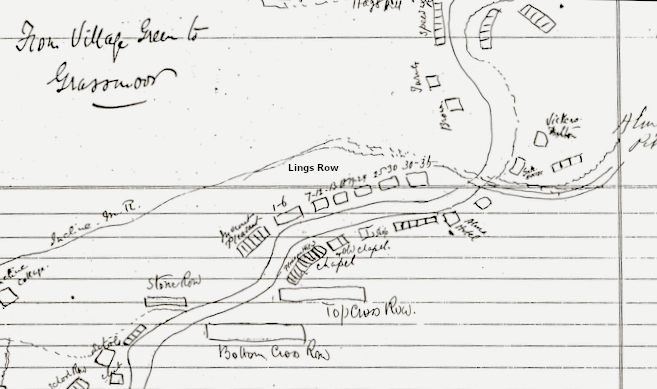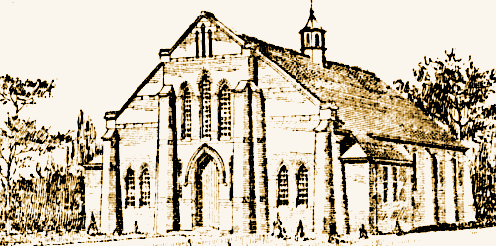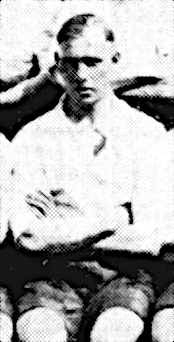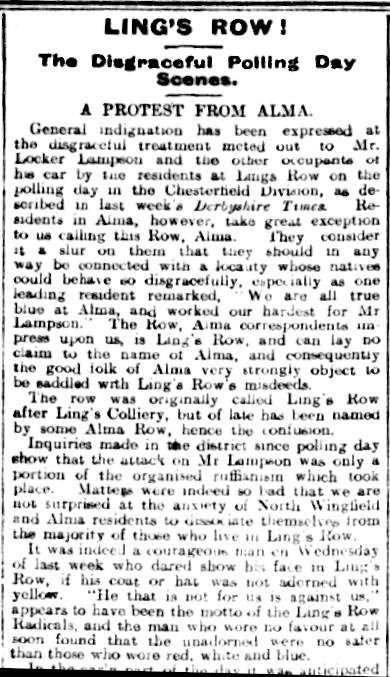
Lings = Heather
The area in North Wingfield township known as Lings was in the manor of Williamthorpe, and lies on the northern edge of North Wingfield’s parish. It is on the border with Grassmoor, and it is easy to imagine that this higher ground on the south-eastern edge of the grassy moor was once covered with heather.
Three Farms became One
By the mid 17th century there were three farms at Lings, of 38, 64 and 93 acres, occupied by tenants of the Hunlokes of Wingerworth Hall. The land belonging to the smallest farm was distributed between the other two farms before 1779, and, after the death of the tenant Mr Francis Browne in 1862, much of the land of the other smaller farm was transferred to the one remaining farm, which increased to about 140 acres. Farming families in the larger farm over the centuries included Brelsford, Ashmore, Bacon, Holmes and Wright.

The last of the Browne family at Lings was Mr Francis Browne who died in 1862. His family claimed to be the descendants of a Civil War Royalist, and made an unsuccessful claim to the vacant Viscountcy of Montague.
When Mr Francis Browne’s youngest son, William Nichols Browne of Brimington (who was born at Lings), gave an interview to the Derbyshire Times in 1901, he recalled that Lady Hunloke (perhaps in jest) referred to his father as ‘Montague’. (Derbyshire Times 16 February 1901).
For more on the Browne family see our facebook post https://www.facebook.com/permalink.php?story_fbid=1384464651564492&id=492150250795941
Lings Colliery
In the 1780s Joseph Butler started a colliery at Lings, which provided coke for his furnaces at Wingerworth and Killamarsh. Coal raised at Lings Colliery was coked before being transported down an incline to a wharf at Ankerbold. The furnace at Wingerworth was blown out in 1816 and the colliery at Lings probably closed shortly afterwards. In the early 1830s there were still coal pits near Lings Farm but it is not clear whether they were being worked, or by whom. The tramroad to Ankerbold had disappeared completely.
In June 1841 work commenced on the second colliery at Lings, this time by the Wingerworth Colliery Company. Coal was taken down to the Midland main line near Clay Cross Station (in Tupton) by a new incline ‘The Duke’s Incline’ managed by the Midland Railway Company. In 1851 there were four households living at Lings Pits.
After some accidents, safety on the Duke’s Incline was improved in the 1860s when a stationary steam engine replaced the self-acting system. The incline was abandoned altogether in the 1870s when the Midland Railway was granted powers to build a network of new junction lines. Lings Colliery was closed in the 1890s.

Lings Rows
Lings Row, a large development of of thirty-six cottages (six blocks of six cottages), was built on a field called ‘Little High Flat’ in the second half of the 1840s. On the 1851 census 34 of the 36 cottages were occupied, and fifty men and boys living here were coal miners. Today Deincourt Crescent occupies the site.

At around the same time that Lings Row was built, two blocks of cottages were built end-on to Chesterfield Road, nearer to North Wingfield Green, on a field named West White Ley (or Leas). These were called Lings Cross Rows. Top Cross Row was made up of a block of six cottages, and Bottom Cross Row was a long block of sixteen cottages. Between 1861 and 1871 another block of six cottages was added to Top Cross Row, making twelve in all. To the north, on the boundary with Grassmoor, another two rows of nineteen cottages called Speedwell Row, were built in a triangle on the corner of a field near Windwhistle Farm called Platt’s Close, circa 1850.

Pubs and Chapels
The Miners Arms, situated opposite Lings Row, began as a butcher’s and grocer’s shop and beerhouse named ‘Clover Tree’ belonging to Charles Todd. It was established there before 1858. By 1861 Todd’s public house was known as ‘The Miners Arms’, and by the 1880s the Miners Arms had become ‘The Alma Hotel’. The public house was closed and demolished at the end of 2005, and there is now high-density housing on the site.

Lings Row (Salem) Chapel was built in 1864. This was replaced by a new building (pictured here), on an adjacent site, around the turn of the century, with accommodation for 400, and the two chapel buildings stood side-by-side, as can be seen on the parish clerk’s sketch, above. The new chapel suffered from subsidence and was closed and offered for sale by the trustees in 1926 “for freehold or dismantling” (Sheffield Daily Telegraph 28 September 1926). It was sold and demolished in 1929. The old chapel was put back into use and eventually closed in 1962.
A Professional Footballer

In 1928 the Sheffield Daily Telegraph reported, “Chesterfield have signed on Fred Beedall, an inside-right, from Lings Row Primitives, a local club. He is 17 years of age, stands 5ft 8in. and is reported to be well endowed physically” (Sheffield Daily Telegraph 9 March 1928). He later became a half-back.
Fred Beedall (1911-1976) played for Chesterfield FC for about six years, although he did not make his league debut until 1932.
In 1901 and 1911 members of the Beedall family lived on Lings Row, Top Cross Row, and Bottom Cross Row, and a local newspaper rather unkindly referred to the Beedalls at North Wingfield as a ‘clan’. Members of the family were still living on Top Cross Row in 1939.
In 1934 Fred Beedall moved to Torquay United, but in 1938 he was placed on the transfer list. He returned to Chesterfield, and in 1939 he was living on Jawbones Hill, and working as a crane driver.
Picture from the Derbyshire Times 20 August 1932.
A Bad Reputation
It was reported that the residents of Alma Row and other residents of North Wingfield wished to be dissociated with the Lings Row radicals who, on polling day in 1906, threw mud, blue water, and worse, at the Unionist candidate Mr Locker Lampson and, indeed, any unfortunate passer-by they suspected to be a Unionist supporter.

Thanks to Cliff Williams for information on The Duke’s Incline.
You must be logged in to post a comment.